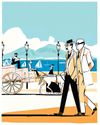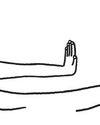
In New York, as in all great seaports, rats abound. One is occasionally in their presence without being aware of it. In the whole city relatively few blocks are entirely free of them. They have diminished greatly in the last twenty-five years, but there still are millions here; some authorities believe that in the five boroughs there is a rat for every human being. During a war, the rat populations of seaports and of ships always shoot up. House rats left their nests in basements and began to dig burrows in vacant lots and parks, particularly Central Park, earlier this spring than they have for many years. A steady increase in shipboard rats began to be noticed in New York Harbor in the summer of 1940, less than a year after the war started in Europe. Rats and rat fleas in many foreign ports are at times infected with the plague, an extraordinarily ugly disease that occurs in several forms, of which the bubonic, the Black Death of the Middle Ages, is the most common. Consequently, all ships that enter the harbor after touching at a foreign port are examined for rats or for signs of rat infestation by officials of the United States Public Health Service, who go out in cutters from a quarantine station on the Staten Island bank of The Narrows. If a ship appears to be excessively infested, it is anchored in the bay or in one of the rivers, its crew is taken off, and its holds and cabins are fumigated with gas so poisonous that a whiff or two will quickly kill a man, let alone a rat. In 1939 the average number of rats killed in a fumigation was 12.4. In 1940 the average rose abruptly to 21, and two years later it reached 32.1. In 1943, furthermore, rats infected with the plague bacteria, Pasteurella pestis, were discovered in the harbor for the first time since 1900. They were taken out of an old French tramp, the Wyoming, in from Casablanca, where the Black Death has been intermittent for centuries.
This story is from the {{IssueName}} edition of {{MagazineName}}.
Start your 7-day Magzter GOLD free trial to access thousands of curated premium stories, and 9,000+ magazines and newspapers.
Already a subscriber ? Sign In
This story is from the {{IssueName}} edition of {{MagazineName}}.
Start your 7-day Magzter GOLD free trial to access thousands of curated premium stories, and 9,000+ magazines and newspapers.
Already a subscriber? Sign In

BADDIE ISSUES
\"Wicked\" and \"Gladiator II.\"

LET'S MAKE A DEAL
\"Death Becomes Her\" and \"Burnout Paradise.\"

ANTI HEROES
\"The Franchise,\" on HBO.

FELLOW-TRAVELLERS
The surprisingly sunny origins of the Frankfurt School.

NOW YOU SEE ME
John Singer Sargent's strange, slippery portraits of an art dealer's family.

PARIS FRIEND - SHUANG XUETAO
Xiaoguo had a terror of thirst, so he kept a glass of water on the table beside his hospital bed. As soon as it was empty, he asked me to refill it. I wanted to warn him that this was unhealthy - guzzling water all night long puts pressure on the kidneys, and pissing that much couldn't be good for his injury. He was tall, though, so I decided his insides could probably cope.

WILD SIDE
Is Lake Tahoe's bear boom getting out of hand?

GETTING A GRIP
Robots learn to use their hands.

WITHHOLDING SEX FROM MY WIFE
In the wake of [the] election, progressive women, who are outraged over Donald Trump's victory at the ballot box, have taken to social media with public, vengeful vows of chastity. - The Free Press.

DEADLINE EXTENSION
Old age, reborn.